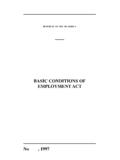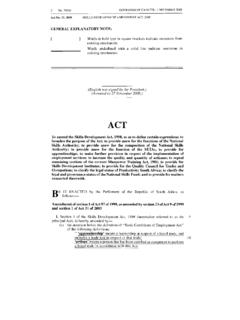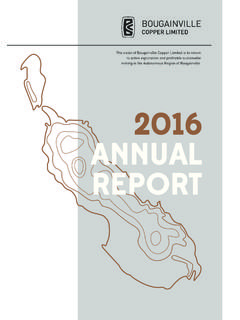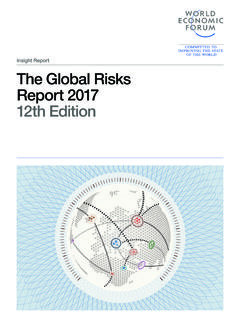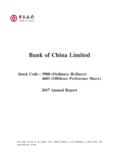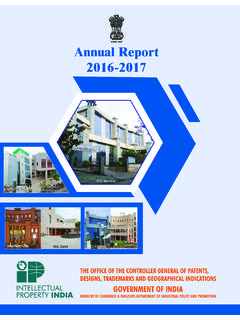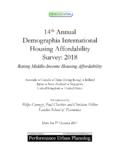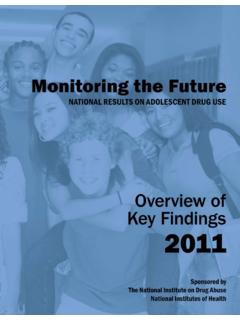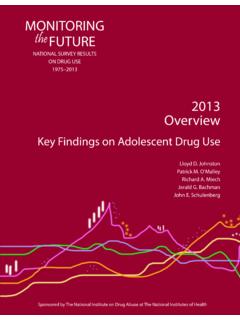Transcription of ANNUAL REPORT - Department of Labour
1 1 COMMISSION FOR EMPLOYMENT EQUITY2011 - 2012 ANNUAL REPORT12thBRIDGING THE EQUITY GAP Creating Equitable Workplaces that are Free from Unfair Discrimination 2 BRIDGING THE EQUITY GAP Creating Equitable Workplaces that are Free from Unfair Discrimination. ICOMMISSION FOR EMPLOYMENT EQUITY2011 - 2012 ANNUAL REPORT12thPublisherDepartment of LabourChief Directorate of CommunicationPrivate Bag X117 Pretoria0001 TextCommission for Employment EquityEditing, Layout and Design, photography and distributionSub-directorate of Media Production, Design Studio (Designer: Nontembiso Kgatle)Chief Directorate of Communication, Department of LabourPrinterGovernment PrintersISBN : OF CONTENTSG lossary IIIF oreword IVMembers of the CEE V1. Introduction 12. Highlights for the period 33. Workforce distribution 74. Employment Equity Value Chain 95. Analysis of employment equity reports received in 2011 Extent of reporting Workforce profile, workforce movement and skills 11 development in terms of race, gender and disability Top management level in terms of race and gender Senior management level in terms of race and gender Professionally qualified level in terms of race and gender Skilled level in terms of race and gender Disability workforce profile 306.
2 Summary and remarks 33 References 34 Appendix A 35 IIIGLOSSARYCOMMISSION Means the Commission for Employment Equity (CEE) Department Means the Department of LabourDG Means the Director-General of the Department of LabourDESIGNATED GROUPS Mean Black people ( Africans, Coloureds and Indians), women and people with disabilities who are natural persons and: Are citizens of the Republic of South Africa by birth or descent Are citizens of the Republic of South Africa by naturalisation before the commencement date ( 27 April 1994) of the interim Constitution of the Republic of South Africa Act of 1993 Became citizens of the Republic of South Africa from the commencement date of the interim Constitution of the Republic of South Africa Act of 1993, but who, not for Apartheid policy that had been in place prior to that date, would have been entitled to acquire citizenship by naturalisation prior to that date FOREIGN NATIONALS Mean those natural persons who are not citizens, or are those who received their citizenship after 26 April 1994 and their descendants SMALL EMPLOYERS Mean those designated employers who employ fewer than 150 employees LARGE EMPLOYERS Mean those designated employers who employ 150 or more employees EAP Means the Economically Active Population (EAP)
3 Which includes people from 15 to 64 years of age who are either employed or unemployed and seeking employment NEDLAC Means National Economic Development and Labour CouncilILO International Labour Organisation IVOn behalf of the Commission for Employment Equity (CEE) it is with great honour and privilege that I present to the honourable Minister of Labour , Ms Oliphant, in terms of section 33 of the Employment Equity Act, No. 55 of 1998, the 12th ANNUAL REPORT of the Commission for Employment Equity. What is evident is the amount of work that still remains in order to improve on creating equitable workplaces that are free from unfair discrimination. One key objective the CEE embarked upon was to introduce amendments to strengthen its compliance and enforcement provisions for improved implementation. Most of the proposed amendments were informed by information gathered from Director-General Review assessments conducted over the past few years, where employers are assessed mainly on their substantive compliance to the Act.
4 The amendment process has been in the pipeline for quite a while and its time consuming negotiations at NEDLAC could further delay the much needed action required, particularly by business, to transform the South African Africa, being a signatory to a number of ILO Conventions, including the convention on discrimination, and being one of the key contributors to the ILO Recommendation on HIV and AIDS in the World of Work of June 2010, have now finalised the review process of its Code on HIV and AIDS in the world of work to bring it fully in line with the Recommendation. This effort is in addition to the headway being made by the country on accessibility to prevention, counselling, testing, treatment and wellness programmes for the poor, unemployed and employed. However, the stigma is not totally gone and we must continuously remind ourselves that employees spend most of their awake-time at work and many of them are breadwinners and therefore their jobs are a lifeline for many immediate extended family growth in the number of fully and accurately employment equity reports received from employers have been largely due to push factors that include tighter regulations and more employers opting for online reporting.
5 The data contained in these reports were both promising and disappointing at the same time. Government is largely progressing very well in eliminating unfair discrimination and in achieving more equitable workplaces; however the CEE is very disappointed with the lack of progress being made in the Western Cape at Government and the Private Sector as well. Government s relatively good progress is also reflected by its inclusion in Community/Social/Personal Services Sector, the best performing sector across most is the pace of transformation pertaining to the equitable representation of Africans, Coloureds, Black women and people with disabilities that continue to concern the CEE the most, as the allocation, recruitment and promotion opportunities still favour Whites according to the reports received from employers in the 2011 reporting period. I therefore take this opportunity to stress that the Employment Equity Act (EEA) is working, which is evident by the progress made by White women and Indians in work places, and if the same vigour and commitment is applied, similar results will be achieved for other designated groups as well.
6 The amendments to the Act, largely informed by the information received from the Director-General Review process conducted over the past few years to strengthen the compliance and enforcement mechanisms, must reach finality as soon as possible in order to effectively implement the critical strategy to promote the implementation of the Act, is stakeholder engagement in order to build and maintain relationships for continued engagement. Engagement on the BBBEE Codes, particularly on the employment equity element, still continues as these Codes are currently undergoing a review process. Transformation will not advance enough to benefit the majority of the populace adequately, unless individuals from the designated groups are largely employed in positions with authority and with real decision-making powers. Whites and males will continue to dominate in the middle-to-upper levels for the next 127 years as long as employers are caught up with the vicious cycle of continuing to employ people with mainly the same race and gender profile that just exited their organisations.
7 Therefore, it is critical for employers to align their employment equity interventions, including skills and succession planning, with its employment equity objectives. Commitment by employers to effectively implement the Act in substance and spirit is likely to assist transformation by creating work places that are equitable in nature and free from discrimination. On behalf of the members of the CEE, I hereby take this opportunity to express our gratitude to the Minister of Labour for her valued support and to officials of the Department of Labour , particularly the Secretariat, for their continued administrative and technical assistance. FOREWORDMpho NkeliCHAIRPERSON: Commission For Employment EquityVMembers of the Commission for Employment Equity are appointed according to section 29 (1) of the Act, which includes the appointment of a Chairperson and eight members nominated by NEDLAC, two representatives of each from the State, Organised Business, Organised Labour and OF THE COMMISSION FOR EMPLOYMENT EQUITYA ndrew MadellaCommunity representativeMalesela Maleka Community representativeVacantState RepresentativeNomvula HadiLabour RepresentativeKhanyisile KweyamaBusiness RepresentativeMpho NkeliChairpersonNomonde MesatywaState RepresentativeVacantLabour representativeJohn BothaBusiness representativeMembers of the CEE are as follows.
8 VIINTRODUCTION11 INTRODUCTIONThis REPORT reflects on the status of employment equity in the country covering the period from 1 April 2011 to 31 March 2012 and which is submitted to the Minister by the Commission for Employment Equity (CEE) in terms of Section 33. The CEE set out the following key strategic objectives for its tenure of five years: Reviewing of the Employment Equity Act (the Act) in order to strengthen the achievement of its objectives Reviewing of the EE regulations to align them with the amended Act Raising awareness and conducting advocacy programmes on legislative changes and their implications Reviewing of the Code of Good Practice on HIV in the Workplace and its Technical Assistance Guidelines to align it with the International Labour Organisation s (ILO) recommendations of June 2010 Reviewing of the Code of Good Practice on People with Disabilities and Employment as well as the Technical Assistance Guidelines (TAG)
9 To bring them in line with any new developments, including the UN Convention on Disability of 2007 Promoting the principle of Equal Pay for Work of Equal Value in terms of ILO Convention 100 Engaging in and improving on collaboration with Chapter 9 Institutions and other stakeholders Monitoring and evaluating the implementation of the Act and advising the Minister REPORT covers highlights for the stated period, the Economically Active Population (EAP) workforce distribution, a trends analysis of information contained in reports received in 2011 for each of the four upper occupational levels Top Management, Senior Management, Professionally Qualified and Skilled Technical. The REPORT also concludes with observations and remarks by the Commission. Employers with 150 or more employees ( large employers) are required to submit reports to the Department on an ANNUAL basis and employers with fewer than 150 employees ( small employers) are expected to submit reports to the Department of Labour every two years.
10 This REPORT therefore only addresses information received from large employers and the trends analysis only focuses on large employers as , this REPORT also provides for the analysis of the four upper levels separately for each of the provinces, business types and sectors as defined in Schedule 4 of the Act. 2 HIGHLIGHTS FOR THE PERIOD23 HIGHLIGHTS FOR THE PERIODThe highlights captured below cover key activities of the CEE in its endeavour to execute its Amendments to the ActThe amending of the Employment Equity Act (the Act) is currently being deliberated at the National Economic and Labour Council (NEDLAC). NEDLAC has three main constituencies, namely Organised Business, Organised Labour and Government, and is a forum for deliberation and negotiation on proposed legislation prior to it reaching Parliament. From time-to-time and in certain Chambers, Community is nominated by NEDLAC and is represented as the fourth constituency on the Commission for Employment Equity (CEE).

